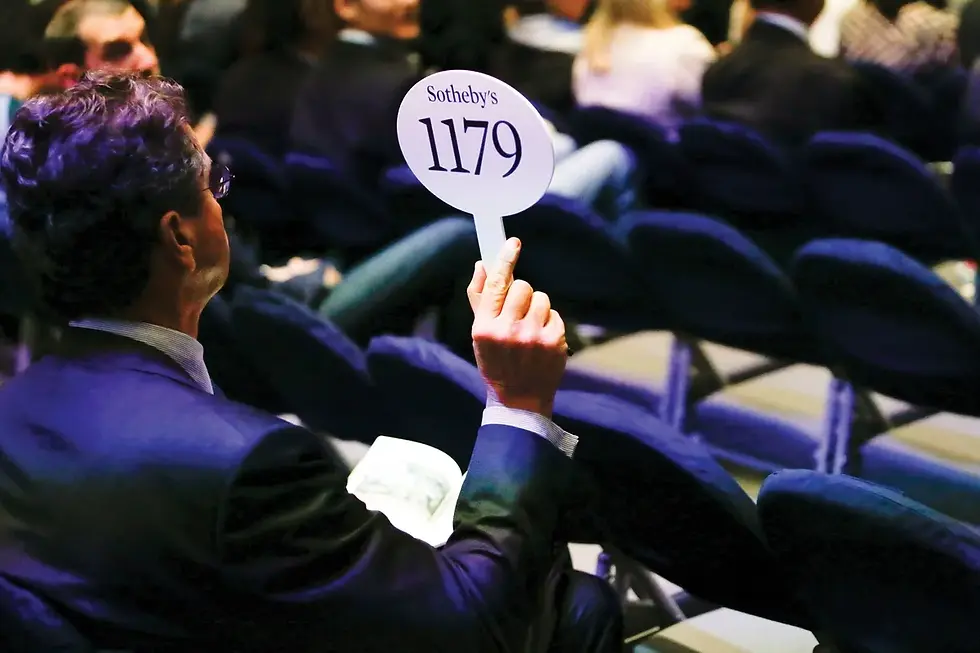Is the art world in the midst of a speculative bubble?
- Yoann Guez
- Jan 20, 2021
- 3 min read
Updated: Jan 17, 2022
Flipping artworks has become common practice among collectors and dealers alike. This trend, which originated in the early 2000s, has clearly accelerated over the last decade with the rise of a new generation of collectors who are more prone to see art as a financial asset among others. Meanwhile, a wave of young artists—whose prices remain considerably lower than their elders—has swept over the art world and is now reigning on the market, thus feeding the appetite of speculators. To that extent, the current situation shows troubling similarities with the 'Zombie Formalism' bubble from the mid-2010s.

In August 2020, Christie’s collaborated with 22 young and mid-career black artists on an online auction sales named Say It Loud (I’m Black and Proud). Well aware that speculation had been raging for emerging artists in the past months, the curator pushed the auction house to have buyers sign a binding five-year non-resale agreement to prevent them from flipping works.

Destinee Ross-Sutton, who curated the sale, must have had Amoako Boafo’s example in mind. The Ghanaian artist, who went from unknown to the world’s hottest rising artist in 2020, saw his prices soar artificially in a few months, culminating with a $1.14 million painting at Christie’s Hong Kong last December. In February 2020, a flipper sold another $881,432 piece, though he had purchased it for 38 times less a few months ago.
According to his American dealer, Roberts Project, speculators who benefited from Boafo’s sudden fame are "all of these white wealthy white collectors who are making huge money off of African artists during Black Lives Matter", without consideration for the artist’s career, which runs a high risk of being permanently damaged by a sudden collapse in prices after the bubble burst.

Amoako Boafo is far from being the sole example of art speculation recently. Indeed, artists like Matthew Wong and Salman Toor—who currently has an acclaimed show at the Whitney Museum—recorded outstanding performances in the last few months although they both had a very short auction presence (i.e. less than two years). It did not prevent them to sell artworks for $4.87 and $4.26 million respectively.
The sudden rise of young painters without institutional legitimacy or solid background is not new. Indeed, the current situation is clearly reminiscent of what happened on the market in the mid-2010s, when a generation of emerging abstract painters saw their prices jump overnight, only to lose up to 90% of their value a few years later. The art critic Walter Robinson coined the famous term 'Zombie Formalism' to describe their work.
You may have already heard some of their names, some of which were on everyone’s lips in the art world five or six years ago, such as Jacob Kasay, Hugh Scott-Douglas, Lucian Smith, Oscar Murillo, Christian Rosa or Israel Lund. Known for their processed-based abstract compositions, they attracted unscrupulous collectors who were looking for short-term profit and flipped them at auction.

Aesthetically, their painting looked nothing like the colourful figurative artworks that enrich today’s speculators... And yet, they both share a highly decorative value and appear fashionable in their respective periods. Unfortunately, the hype did not last long for Zombie Formalists, as most of them saw their prices collapse at auction in the late 2010s. Take for instance Lucian Smith’s Rain Paintings, one of which reached an historic high in 2014 when it was acquired for a record-breaking $372,000. In 2017, a larger painting from the same series was sold for $37,500.

How did that happen ? Well, the early 2010s were an unprecedented period of undiscontinued growth for American economy, which was recovering from the subprime crisis. Interest rates had fallen to a historic level, thus encouraging financial investments—and art was one of the strongest of them all. Indeed, the art market had proved resilient after the 2008 crash in a way that was described by the Financial Times as "gravity defying". The 2010s were also a period of transition where the traditional collector’s profile evolved from senior conservative businessmen interested in the long-term growth of their artists to a younger generation of international collectors who see art as an investment among others.
Admittedly, times have changed dramatically since the early 2010s. The global economy is now facing an unprecedented global health crisis, and the art world is no exception. And yet, the current situation encourages collectors to concentrate on mid-price artworks often made by emerging artists, thus turning away from multi-million dollar blue-chip profiles. Indeed, the latters have underperformed at auction in the last few months, which was obvious during London Fall auctions last November for instance.
There is a risk that some of today’s speculative art stars sink as fast as they rose to fame in the coming years. Indeed, crises are known to bring important market corrections, as only a handful of chosen ones are able to achieve long-term commercial growth. Although it is still unclear which artists will survive the current turmoil, some certainly will not.




Comments